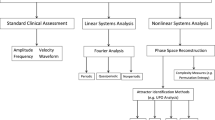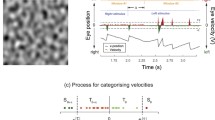Abstract.
Histograms of fast-phase intervals in human optokinetic and vestibular nystagmus were generated, and fitted to statistical distributions used in previous studies. The distributions did not depend on stimulation type (optokinetic or vestibular). An inverse Gaussian or a gamma distribution fitted the data better than did a reciprocal Gaussian distribution, but none fitted the data especially well. In some cases, however, the interpretation of these distributions is more physiologically satisfactory than in others. Recommendations are made on which class of models is preferred, and the experiments needed to support the particular models. Our results call into question the validity of previous studies that fit statistical distributions to data sets of a size comparable to ours.
Similar content being viewed by others
Explore related subjects
Discover the latest articles and news from researchers in related subjects, suggested using machine learning.Author information
Authors and Affiliations
Additional information
Received: 26 June 2001 / Accepted in revised form: 20 February 2002
Rights and permissions
About this article
Cite this article
Trillenberg, P., Zee, D. & Shelhamer, M. On the distribution of fast-phase intervals in optokinetic and vestibular nystagmus. Biol Cybern 87, 68–78 (2002). https://doi.org/10.1007/s00422-002-0324-3
Issue Date:
DOI: https://doi.org/10.1007/s00422-002-0324-3




